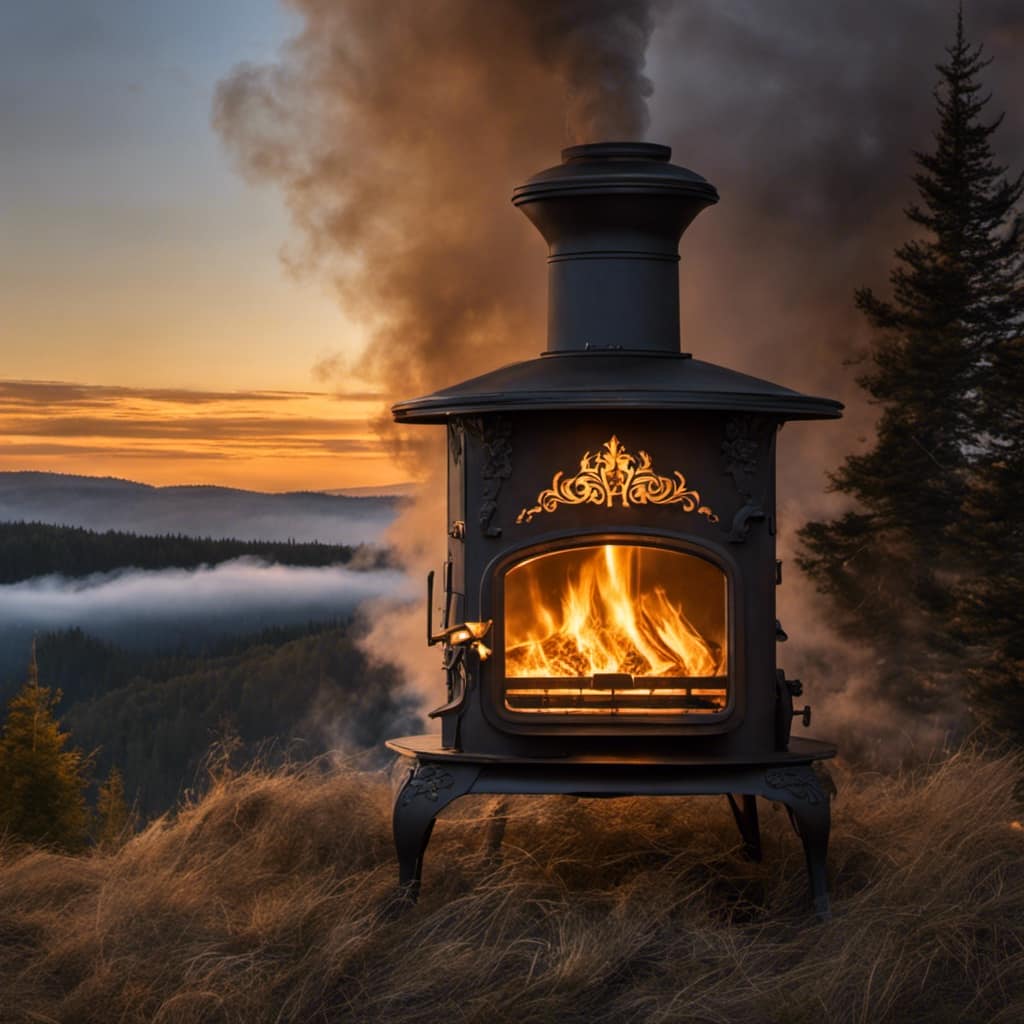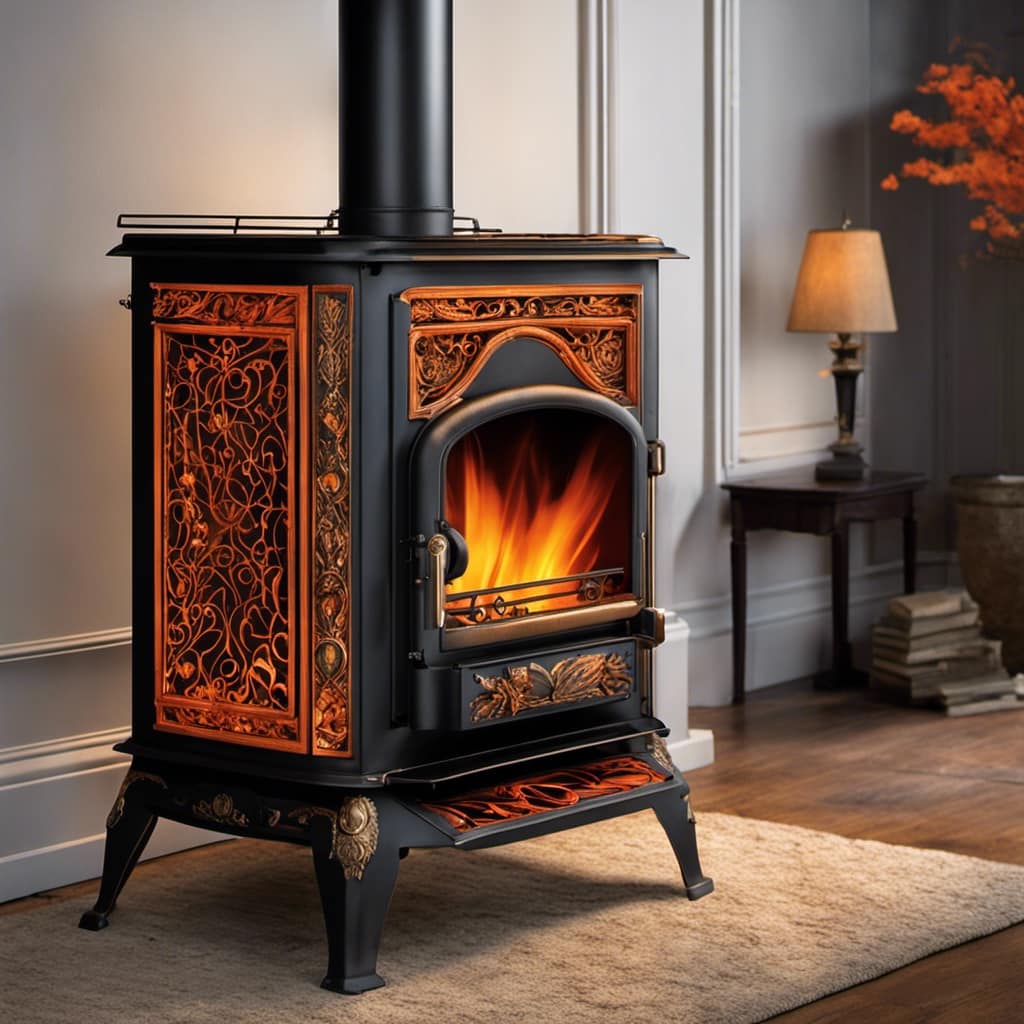I have always appreciated the comforting heat that a wood stove provides. Dealing with the cold can sometimes feel like a constant struggle. However, after some experimentation, I found a few techniques that really helped. In this article, I will discuss my tips for efficiently spreading warmth from a wood stove to the upper levels of a home.
No more chilly nights or wasted energy – let’s make every corner of your home feel like a toasty haven.
Key Takeaways
- Proper home insulation is crucial for maintaining energy efficiency and preventing heat loss.
- Utilizing a heat transfer system with ducts and fans can distribute heat from the wood stove to the upper level of the home, improving thermal efficiency.
- Installing ceiling fans can enhance the efficiency of the heat transfer system by effectively circulating warm air.
- Properly installed and maintained vents and ducts optimize airflow, improving comfort and efficiency.
Insulate Your Home Properly
I can feel a significant difference in temperature upstairs after properly insulating my home. Home insulation plays a crucial role in maintaining energy efficiency and ensuring that the heat generated by my wood stove stays inside my house.
By insulating the walls, roof, and floors, I’ve minimized heat loss and reduced the need for constant heating. Insulation acts as a barrier, preventing the transfer of heat between the inside and outside of my home. This helps to keep the warm air upstairs where I need it the most.

With improved insulation, I can now rely on a more efficient heat transfer system to distribute the warmth evenly throughout my entire house.
Use a Heat Transfer System
Using a heat transfer system, I can effectively distribute warmth from the wood stove to the upper level of my home. Heat distribution is a crucial aspect of achieving thermal efficiency in any heating system. By utilizing a heat transfer system, I can ensure that the heat generated by the wood stove is evenly spread throughout my entire house, including the upper level.
This system consists of a network of ducts and fans that work together to transfer the heat from the stove and distribute it to different areas of the house. The ducts are strategically placed in the walls and floors to maximize heat flow, while the fans help to push the warm air upwards.
Install Ceiling Fans
Installing ceiling fans is a practical solution to enhance the efficiency of the heat transfer system. Energy efficient fans are designed to circulate air effectively, ensuring that the warm air from the wood stove is evenly distributed throughout the room and upstairs.

When installing ceiling fans, there are a few tips to keep in mind. First, choose a fan with the appropriate size and blade pitch to suit the room’s dimensions. Secondly, ensure that the fan is securely mounted to the ceiling to prevent any accidents. Lastly, consider installing a fan with a reversible feature, so it can be used to distribute cool air during the summer months as well.
Optimize Airflow With Vents and Ducts
To optimize airflow in my home, I can ensure that vents and ducts are properly installed and maintained. Air circulation is crucial for maintaining a comfortable and healthy indoor environment.
By regularly cleaning and inspecting vents, I can prevent any blockages or obstructions that could impede airflow.
Additionally, I can make floor plan adjustments to promote better air circulation. This can include rearranging furniture to ensure that vents aren’t blocked, or considering the addition of extra vents in areas with poor airflow.

By optimizing the airflow in my home, I can improve the overall comfort and efficiency of my heating and cooling systems.
With proper airflow in place, I can now consider installing a wood stove fan to further enhance the distribution of heat throughout my home.
Consider Installing a Wood Stove Fan
I can enhance the distribution of heat throughout my home by considering the addition of a wood stove fan.
A wood stove fan is a device that sits on top of your wood stove and helps to circulate the warm air more effectively. By using a wood stove fan, you can ensure that the heat is distributed evenly, reducing cold spots in your home.

Additionally, wood stove fans are relatively easy to install and operate. They typically require minimal maintenance, but it’s important to keep the fan clean and free from dust and debris. Regularly check and clean the fan blades and lubricate the motor if necessary.
With a wood stove fan, you can enjoy the benefits of improved heat distribution and a more comfortable living space.
Frequently Asked Questions
Can I Use a Wood Stove Fan With Any Type of Wood Stove?
Yes, you can use a wood stove fan with any type of wood stove. Wood stove fans help circulate warm air throughout the room, increasing heat distribution and efficiency. They are a popular alternative to other heat transfer systems.
Are There Any Safety Precautions I Should Take When Using a Heat Transfer System?
When using a heat transfer system, it is important to take safety precautions. Ensure proper installation and maintenance of the system, including regular cleaning of the chimney and stove. Follow manufacturer guidelines and have a fire extinguisher nearby.

Will Installing Ceiling Fans Alone Be Enough to Distribute Heat Upstairs?
Installing ceiling fans alone may not be enough to distribute heat upstairs. Consider alternative heat distribution methods such as using a heat transfer system or installing ductwork to ensure efficient and effective heating throughout the entire house.
How Can I Determine if My Home Is Properly Insulated?
Evaluating insulation efficiency is crucial to determine if my home is properly insulated. Proper insulation has numerous benefits, such as reducing energy consumption, improving comfort, and increasing the effectiveness of heating and cooling systems.
Can I Use Vents and Ducts to Redirect the Heat From the Wood Stove to Specific Rooms Upstairs?
Yes, vents and ducts can be used to distribute heat from the wood stove to specific rooms upstairs. This method ensures efficient heat distribution and can be further enhanced with a wood stove fan for optimal results.
Conclusion
In conclusion, maximizing the heat distribution from a wood stove upstairs requires a combination of insulation, heat transfer systems, ceiling fans, and optimized airflow.

One interesting statistic to note is that properly insulating your home can reduce heating costs by up to 30%.
By implementing these strategies, homeowners can effectively harness the heat from their wood stove and ensure a comfortable and efficient heating system throughout their entire home.
Growing up surrounded by the vast beauty of nature, Sierra was always drawn to the call of the wild. While others sought the comfort of the familiar, she ventured out, embracing the unpredictable and finding stories in the heartbeat of nature.
At the epicenter of every remarkable venture lies a dynamic team—a fusion of diverse talents, visions, and passions. The essence of Best Small Wood Stoves is crafted and refined by such a trio: Sierra, Logan, and Terra. Their collective expertise has transformed the platform into a leading authority on small wood stoves, radiating warmth and knowledge in equal measure.











